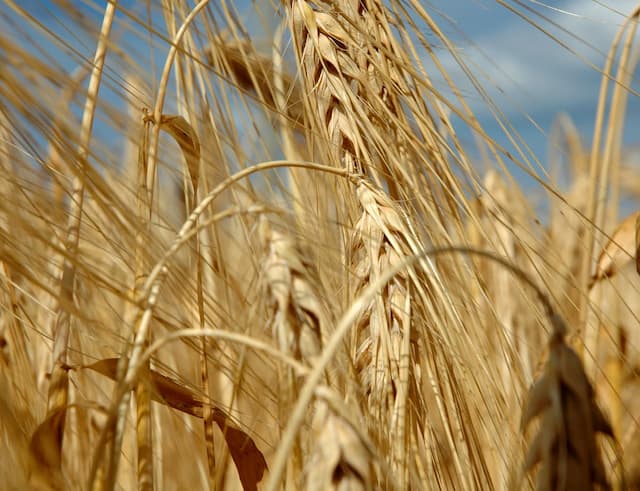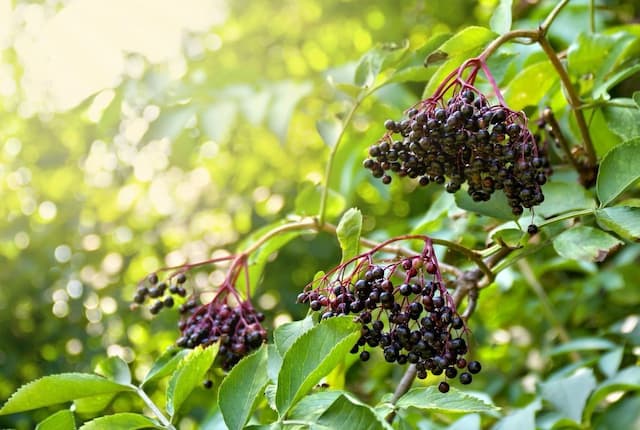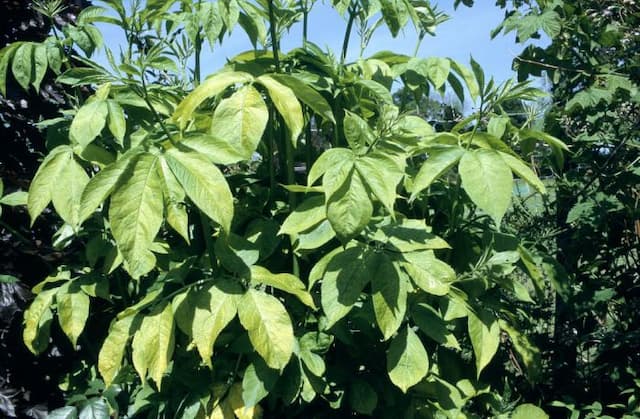Welsh Gold Elderberry Sambucus Welsh Gold = 'Walfinb' (PBR)

ABOUT
The plant known as Sambucus Welsh Gold or simply 'Welsh Gold Elder' has a distinctive and charming appearance that makes it a popular choice for gardeners seeking ornamental flair. It features lush foliage where each leaf is a sight to behold, typically characterized by a bright, golden-yellow hue that can add a warm radiance to any garden space. This vivid coloration of the leaves often contrasts beautifully with the darker stems, creating a striking visual effect. As the seasons change, the Welsh Gold Elder provides a dynamic display of color transitions. In the spring, the new growth often emerges in various shades of green with golden highlights, signaling the start of the growing season with a burst of fresh color. As the plant matures and the leaves fully develop, they take on their characteristic golden tones that capture the light and add luminance to the plant's surroundings. Flowering adds another level of appeal to the Welsh Gold Elder. Clusters of tiny, cream-colored flowers bloom in large, flat-topped groupings that can give off a sweet, subtle fragrance. These flowers not only accentuate the beauty of the foliage but also attract a variety of pollinators such as bees and butterflies, adding life and movement to the garden space. After the flowering period, the Welsh Gold Elder may produce small clusters of berries that add yet another element of visual interest. The berries can range in color, often a shade that complements the plant's overall color scheme, offering a touch of contrast against the golden foliage. Throughout the growing season, the Welsh Gold Elder continues to captivate with its leaf colors, from the vibrant green-gold of new growth to the established golden-yellow that can last until the colder months. When the plant's leaves eventually turn and drop, it provides an opportunity to appreciate the underlying structure and form of the Elder, with its attractive branching pattern that holds interest even without foliage.
About this plant
 Names
NamesFamily
Adoxaceae.
Synonyms
Welsh Gold Elderberry, Golden Elderberry, Variegated Elder.
Common names
Sambucus nigra 'Welfinb' (PBR).
 Toxicity
ToxicityTo humans
Elderberry plants, including the cultivar Sambucus Welsh Gold 'Walfinb' (PBR), contain toxic substances in their leaves, stems, seeds, and unripe fruit. These parts of the plant contain cyanogenic glycosides which can release cyanide when ingested. Consumption can lead to symptoms such as nausea, vomiting, diarrhea, dizziness, and in severe cases, respiratory failure and even coma. It is important not to consume any part of the elderberry plant that has not been properly prepared or is unripe, as this can result in toxicity.
To pets
Elderberry, including the cultivar Sambucus Welsh Gold 'Walfinb' (PBR), can also be toxic to pets if they consume the leaves, stems, seeds, or unripe berries. These parts of the plant contain compounds that can be converted into cyanide in the body and lead to cyanide poisoning. Symptoms of poisoning in pets may include vomiting, diarrhea, abdominal pain, lethargy, and difficulty breathing. In extreme cases, seizures, coma, and death may occur. It is essential to keep pets away from elderberry plants, specifically the parts that contain these toxic substances.
 Characteristics
CharacteristicsLife cycle
Perennials
Foliage type
Deciduous
Color of leaves
Variegated
Flower color
White
Height
6 feet (1.8 meters)
Spread
6 feet (1.8 meters)
Plant type
Shrub
Hardiness zones
5
Native area
Europe
Benefits
 General Benefits
General Benefits- Ornamental Appeal: Sambucus Welsh Gold, also known as Elderberry 'Walfinb', has vibrant gold and green variegated foliage and delicate white flowers, making it a visually striking addition to any garden.
- Attracts Wildlife: It provides nectar for pollinators, such as bees and butterflies, thus supporting local ecosystems.
- Edible Fruits: Elderberry 'Walfinb' produces berries that can be used in jams, jellies, and wines, though they should be cooked before consumption.
- Adaptability: This plant is adaptable to a range of soil types, provided they are well-drained.
- Drought Tolerance: Once established, Elderberry 'Walfinb' has good drought tolerance, making it suitable for gardens in drier climates.
- Low Maintenance: It requires minimal pruning and care once established, making it suitable for gardeners of all skill levels.
- Seasonal Interest: This variety of elderberry offers year-round interest with flowers in spring, fruits in summer, and colorful foliage throughout the growing season.
- Privacy Screening: Its growth habit can provide a natural screen or hedge, offering privacy and shelter to a garden space.
- Tolerance to Cold: Elderberry 'Walfinb' is generally hardy in cold temperatures, which makes it suitable for planting in many temperate regions.
 Medical Properties
Medical PropertiesThis plant is not used for medical purposes.
 Air-purifying Qualities
Air-purifying QualitiesThis plant is not specifically known for air purifying qualities.
 Other Uses
Other Uses- Floral Arrangements: The flowers of elderberry can be used in dried floral arrangements, adding a unique and vibrant touch to bouquets and centerpieces.
- Culinary Coloring: Elderberry flowers can be used to add natural yellow coloring to desserts and baked goods, as an alternative to artificial food dyes.
- Photography and Art: The striking appearance of elderberry plants, especially when in bloom, makes them a popular subject for botanical photographers and artists.
- Eco-Friendly Dye for Fabrics: Both flowers and berries can be boiled to produce natural dyes for coloring textiles in shades of yellow or blue, depending on the plant part used.
- Craft Projects: Elderberry branches are flexible and can be used for making small handcrafted items such as wreaths, ornaments, or even simple rustic furniture.
- Garden Design: Elderberry plants like 'Welsh Gold' can be used to create a focal point in garden designs because of their distinctive foliage and flowers.
- Horticultural Education: These plants serve as a practical example in educational settings to demonstrate plant growth, pollination, and fruit development processes.
- Erosion Control: Elderberry bushes can be utilized in landscaping to help stabilize soil and prevent erosion due to their dense root systems.
- Insect Habitat: They offer habitat and food sources for beneficial insects such as bees and butterflies, contributing to local biodiversity.
- Bird Support: The berries provide a vital food source for birds during late summer and fall, helping to support avian populations.
Interesting Facts
 Feng Shui
Feng ShuiElderberry is not used in Feng Shui practice.
 Zodiac Sign Compitability
Zodiac Sign CompitabilityElderberry is not used in astrology practice.
 Plant Symbolism
Plant Symbolism- Protection: The common Elderberry is often associated with protection in folklore. Elder trees were thought to ward off evil spirits or negative energies when planted near a house.
- Healing: Elderberry has a history of medicinal use. The berries and flowers are believed to boost the immune system and have healing properties.
- Rebirth: In some traditions, the Elder tree symbolizes rebirth and renewal, as it is one of the first plants to produce new leaves in the spring.
- Transformation: Elderberries' ability to change from flowers to berries has made them a symbol of transformation and the progression of life stages.
 Water
WaterThe Golden Elderberry ('Walfinb') prefers consistent moisture but does not like to be waterlogged, so water it deeply once a week with about 1-2 gallons of water, depending on the weather conditions and soil drainage. During hot and dry periods, you may need to water it twice a week to maintain moisture levels, but always check the soil before watering to ensure it's not already moist. In the winter months, reduce the watering to match the plant’s reduced needs as it goes dormant, and make sure that the soil drains well to prevent root rot.
 Light
LightThe Golden Elderberry ('Walfinb') thrives in full sun to partial shade. It performs best in a location where it can receive at least six to eight hours of direct sunlight daily. A spot with morning sun and afternoon shade is ideal, particularly in regions with very hot summers, to protect the foliage from harsh afternoon sun.
 Temperature
TemperatureThe Golden Elderberry ('Walfinb') is relatively hardy and can tolerate temperatures as low as 0°F but prefers a range between 60°F and 80°F for optimal growth. It's important to protect the plant from extreme heat and frost, as temperatures exceeding 95°F or dropping below freezing can stress the plant and damage foliage.
 Pruning
PruningPruning the Golden Elderberry ('Walfinb') is important for shaping the plant, encouraging new growth, and removing any dead or diseased wood. Prune in late winter or early spring before new growth starts. It is advisable to remove no more than one-third of the growth annually, which will invigorate the plant and promote a bushier habit.
 Cleaning
CleaningAs needed
 Soil
SoilFor Elderberry 'Welsh Gold', the ideal soil mix is well-draining with a high organic matter content. A good mix could be composed of loamy garden soil, peat or compost, and sandy or perlite components to ensure proper drainage. The preferred soil pH for Elderberry 'Welsh Gold' is slightly acidic to neutral, ranging from 5.5 to 7.0.
 Repotting
RepottingElderberry 'Welsh Gold' generally does not need frequent repotting as it is often grown outdoors. If grown in containers, repotting every 2 to 3 years should suffice, or when it becomes root-bound.
 Humidity & Misting
Humidity & MistingElderberry 'Welsh Gold' tolerates a wide range of humidity levels but prefers moderate to high humidity. It thrives outdoors where natural humidity usually provides adequate conditions.
 Suitable locations
Suitable locationsIndoor
Place Elderberry 'Welsh Gold' in bright, indirect light and monitor moisture.
Outdoor
Plant in sun to partial shade, ensure moist, well-drained soil.
Hardiness zone
4-7 USDA
 Life cycle
Life cycleThe life cycle of the 'Welsh Gold' Elderberry, Sambucus nigra 'Walfinb' (PBR), begins with germination, where the seed sprouts and establishes a root system, typically in the spring. The seedling stage follows, during which the plant develops its first set of true leaves and begins photosynthesis. As the plant enters the vegetative growth stage, it produces a bushy habit with characteristic golden-yellow leaves, growing larger and stronger through the season. The Elderberry reaches maturity within a few years, flowering in early summer with creamy, fragrant blossoms that attract pollinators. After pollination, the plant produces clusters of berries that ripen by late summer to early fall, which can be harvested for their culinary and medicinal value. As a perennial, the Elderberry enters a period of dormancy in the winter, where growth ceases and the plant rests until the warmer temperatures of spring stimulate the next growth cycle.
 Propogation
PropogationPropogation time
Spring-Early Summer
Sambucus Welsh Gold, also known as 'Walfinb' (PBR), can be propagated through softwood cuttings typically in late spring or early summer when the plant's new growth is still soft and pliable. To propagate by this method, a gardener would cut a section of the stem, usually 4 to 6 inches long, from a healthy part of the plant just below a leaf node. This cutting should include at least two sets of leaves at the top. The lower leaves are then removed, and the cut end may be dipped in rooting hormone to encourage root growth. The cutting is then planted in a well-draining potting mix and kept in a warm, humid environment until roots have developed, often taking 6 to 8 weeks. During this time, the soil must be kept moist but not waterlogged, and the cutting should be protected from direct sunlight to prevent scorching. Once the cutting has established a good root system, it can be transplanted into the garden or a more permanent container.




![Elder [Black Tower]](/_next/image?url=https%3A%2F%2Fplants-admin.emdemapps.com%2Fimages%2Fplants%2F%2Fimages%2F604b5cad99578.png&w=640&q=75)




